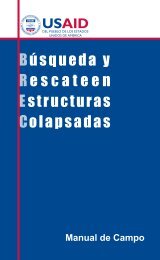Humanitarian Supply Management and Logistics in the Health Sector
Humanitarian Supply Management and Logistics in the Health Sector
Humanitarian Supply Management and Logistics in the Health Sector
Create successful ePaper yourself
Turn your PDF publications into a flip-book with our unique Google optimized e-Paper software.
◆ Availability of food: Not all events lead to dw<strong>in</strong>dl<strong>in</strong>g stocks of food,<br />
but people who have lost <strong>the</strong>ir homes or belong<strong>in</strong>gs will likely<br />
require some temporary support <strong>in</strong> this regard.<br />
◆ Shelter: The impact of a disaster might force people to look for temporary<br />
shelter until <strong>the</strong>y resolve <strong>the</strong>ir hous<strong>in</strong>g situation.<br />
◆ Sanitation: The generally sudden disruptions of <strong>the</strong> everyday function<strong>in</strong>g<br />
of a community, as well as <strong>the</strong> displacement or temporary<br />
resettlement of <strong>the</strong> victims, can cause environmental degradation <strong>and</strong><br />
imperil health due to a rise <strong>in</strong> unsanitary conditions.<br />
Bear<strong>in</strong>g <strong>in</strong> m<strong>in</strong>d which k<strong>in</strong>d of disaster we are fac<strong>in</strong>g, we can come to<br />
prelim<strong>in</strong>ary conclusions on what type of assistance will most likely be<br />
necessary, <strong>and</strong> launch an appropriate response <strong>in</strong> <strong>the</strong> field until more<br />
thorough assessments reveal to us <strong>in</strong> greater detail <strong>the</strong> needs that must be<br />
met.<br />
Operational Needs<br />
All too often, local organizations <strong>in</strong>volved <strong>in</strong> emergency response do not<br />
have <strong>the</strong> resources to respond effectively to a disaster. It is <strong>the</strong>refore<br />
important to determ<strong>in</strong>e what resources an organization has (or is lack<strong>in</strong>g),<br />
<strong>and</strong> what is required for relief operations to be carried out effectively. If<br />
logistical plann<strong>in</strong>g <strong>and</strong> preparations have taken place before <strong>the</strong> event,<br />
this will make it easier to determ<strong>in</strong>e which resources are available—<strong>and</strong><br />
which are lack<strong>in</strong>g <strong>and</strong> must be procured elsewhere. (See also <strong>the</strong> section<br />
on <strong>Logistics</strong> Plann<strong>in</strong>g <strong>and</strong> Preparedness <strong>in</strong> Chapter 2.)<br />
Assessment of Local Capacity<br />
By local capacity we mean not only <strong>the</strong> physical resources available at<br />
<strong>the</strong> site of an emergency, but any factors that may help emergency supply<br />
management, such as local knowledge of <strong>the</strong> terra<strong>in</strong> or wea<strong>the</strong>r patterns,<br />
or social capital <strong>in</strong> <strong>the</strong> form of community organizations, formal<br />
<strong>and</strong> <strong>in</strong>formal communications channels, <strong>and</strong> <strong>the</strong> like.<br />
Local Infrastructure Capacity<br />
Chapter 3: Assess<strong>in</strong>g logistical <strong>and</strong> supply needs 17<br />
S<strong>in</strong>ce disasters tend to affect lifel<strong>in</strong>es, <strong>in</strong>clud<strong>in</strong>g roads <strong>and</strong> <strong>in</strong>frastructure<br />
<strong>in</strong> general, it is essential to carry out a quick <strong>in</strong>ventory of <strong>the</strong>ir availabil-






